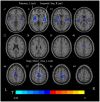The Effect of Repetitive Transcranial Magnetic Stimulation of Cerebellar Swallowing Cortex on Brain Neural Activities: A Resting-State fMRI Study
- PMID: 35572005
- PMCID: PMC9094708
- DOI: 10.3389/fnhum.2022.802996
The Effect of Repetitive Transcranial Magnetic Stimulation of Cerebellar Swallowing Cortex on Brain Neural Activities: A Resting-State fMRI Study
Abstract
Objective: The effects and possible mechanisms of cerebellar high-frequency repetitive transcranial magnetic stimulation (rTMS) on swallowing-related neural networks were studied using resting-state functional magnetic resonance imaging (rs-fMRI).
Method: A total of 23 healthy volunteers were recruited, and 19 healthy volunteers were finally included for the statistical analysis. Before stimulation, the cerebellar hemisphere dominant for swallowing was determined by the single-pulse TMS. The cerebellar representation of the suprahyoid muscles of this hemisphere was selected as the target for stimulation with 10 Hz rTMS, 100% resting motor threshold (rMT), and 250 pulses, with every 1 s of stimulation followed by an interval of 9 s. The motor evoked potential (MEP) amplitude of the suprahyoid muscles in the bilateral cerebral cortex was measured before and after stimulation to evaluate the cortical excitability. Forty-eight hours after elution, rTMS was reapplied on the dominant cerebellar representation of the suprahyoid muscles with the same stimulation parameters. Rs-fMRI was performed before and after stimulation to observe the changes in amplitude of low-frequency fluctuation (ALFF) and regional homology (ReHo) at 0.01-0.08 Hz, 0.01-0.027 Hz, and 0.027-0.073 Hz.
Results: After cerebellar high-frequency rTMS, MEP recorded from swallowing-related bilateral cerebral cortex was increased. The results of rs-fMRI showed that at 0.01-0.08 Hz, ALFF was increased at the pons, right cerebellum, and medulla and decreased at the left temporal lobe, and ReHo was decreased at the left insular lobe, right temporal lobe, and corpus callosum. At 0.01-0.027 Hz, ALFF was decreased at the left temporal lobe, and ReHo was decreased at the right temporal lobe, left putamen, and left supplementary motor area.
Conclusion: Repetitive transcranial magnetic stimulation of the swallowing cortex in the dominant cerebellar hemisphere increased the bilateral cerebral swallowing cortex excitability and enhanced pontine, bulbar, and cerebellar spontaneous neural activity, suggesting that unilateral high-frequency stimulation of the cerebellum can excite both brainstem and cortical swallowing centers. These findings all provide favorable support for the application of cerebellar rTMS in the clinical practice.
Keywords: cerebellum; motor evoked potentials (MEP); repetitive transcranial magnetic stimulation (rTMS); resting-state functional magnetic resonance imaging (rs-fMRI); swallowing.
Copyright © 2022 Dong, Ma, Wang, Pan, Wang, Han and Meng.
Conflict of interest statement
The authors declare that the research was conducted in the absence of any commercial or financial relationships that could be construed as a potential conflict of interest.
Figures








Similar articles
-
The effects of intermittent theta burst stimulation of the unilateral cerebellar hemisphere on swallowing-related brain regions in healthy subjects.Front Hum Neurosci. 2023 Mar 30;17:1100320. doi: 10.3389/fnhum.2023.1100320. eCollection 2023. Front Hum Neurosci. 2023. PMID: 37063103 Free PMC article.
-
High-Frequency Cerebellar rTMS Improves the Swallowing Function of Patients with Dysphagia after Brainstem Stroke.Neural Plast. 2022 Aug 11;2022:6259693. doi: 10.1155/2022/6259693. eCollection 2022. Neural Plast. 2022. PMID: 35992301 Free PMC article.
-
The After-Effects of Theta Burst Stimulation Over the Cortex of the Suprahyoid Muscle on Regional Homogeneity in Healthy Subjects.Front Behav Neurosci. 2019 Mar 1;13:35. doi: 10.3389/fnbeh.2019.00035. eCollection 2019. Front Behav Neurosci. 2019. PMID: 30881294 Free PMC article.
-
Intensity-dependent regional cerebral blood flow during 1-Hz repetitive transcranial magnetic stimulation (rTMS) in healthy volunteers studied with H215O positron emission tomography: I. Effects of primary motor cortex rTMS.Biol Psychiatry. 2003 Oct 15;54(8):818-25. doi: 10.1016/s0006-3223(03)00002-7. Biol Psychiatry. 2003. PMID: 14550681 Review.
-
The Role of the Cerebellum in Swallowing.Dysphagia. 2023 Apr;38(2):497-509. doi: 10.1007/s00455-021-10271-x. Epub 2021 Mar 6. Dysphagia. 2023. PMID: 33675425 Free PMC article. Review.
Cited by
-
Determining the Optimal Stimulation Sessions for TMS-Induced Recovery of Upper Extremity Motor Function Post Stroke: A Randomized Controlled Trial.Brain Sci. 2023 Nov 30;13(12):1662. doi: 10.3390/brainsci13121662. Brain Sci. 2023. PMID: 38137110 Free PMC article.
-
Impact of rTMS and iTBS on Cerebral Hemodynamics and Swallowing in Unilateral Stroke: Insights from fNIRS.Med Sci Monit. 2025 Jan 10;31:e944521. doi: 10.12659/MSM.944521. Med Sci Monit. 2025. PMID: 39789787 Free PMC article.
-
Repetitive transcranial magnetic stimulation improves cognition, depression, and walking ability in patients with Parkinson's disease: a meta-analysis.BMC Neurol. 2024 Dec 24;24(1):490. doi: 10.1186/s12883-024-03990-9. BMC Neurol. 2024. PMID: 39716169 Free PMC article.
-
Effects of Combined Repetitive Transcranial Magnetic Stimulation and Chin-tuck Against Resistance Dual Stimulation on Swallowing: An fNIRS and EMG Study.Dysphagia. 2025 Jun 17. doi: 10.1007/s00455-025-10847-x. Online ahead of print. Dysphagia. 2025. PMID: 40528012
-
The effects of intermittent theta burst stimulation of the unilateral cerebellar hemisphere on swallowing-related brain regions in healthy subjects.Front Hum Neurosci. 2023 Mar 30;17:1100320. doi: 10.3389/fnhum.2023.1100320. eCollection 2023. Front Hum Neurosci. 2023. PMID: 37063103 Free PMC article.
References
LinkOut - more resources
Full Text Sources

